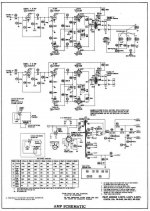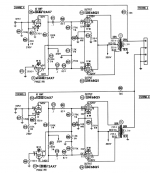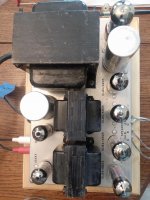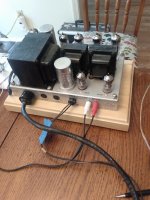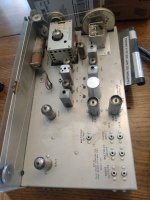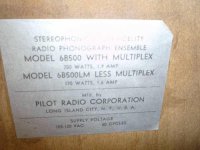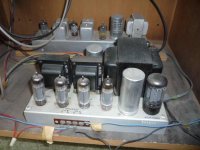Some years ago I tore apart a couple of console units. One was a Pilot 505. I put new capacitors in the amp and was working on the MPX unit when I got distracted and never got back. I've just ordered JJ tubes for the amp and would like to see if it works.
What can I do for a pre-amp? I'd like to build your kit unit but haven't the time right now. Is there a reasonable priced phono unit I could use just to test this?
What kind of power does it have and what to do for speakers? The original speakers were largish but without heavy magnets and no enclosure so I'm guessing I need easy to drive speakers, correct?
(this stuff is probably in your beginner's thread, sorry.)
What can I do for a pre-amp? I'd like to build your kit unit but haven't the time right now. Is there a reasonable priced phono unit I could use just to test this?
What kind of power does it have and what to do for speakers? The original speakers were largish but without heavy magnets and no enclosure so I'm guessing I need easy to drive speakers, correct?
(this stuff is probably in your beginner's thread, sorry.)
If, like the Pilot SA-232, the 505 uses PP EL84 O/P tubes, expect 15 or so WPC. 91 dB. sensitive speakers, with a reasonably flat impedance curve, will be satisfactory.
A 50 KOhm ganged, stereo, volume control like this is all the preamp you need in combination with a CDP. Low capacitance wiring between control and amp is essential.
The piezoelectric cartridges found in most old consoles damage precious LPs. OTOH, consumer grade TTs fitted with "P" mount system moving magnet cartridges are tolerable and (perhaps) a bit more. You need a phono stage for magnetic cartridges and Jim Hagerman offers something pretty darned good, for not many $. Look here.
OTOH, consumer grade TTs fitted with "P" mount system moving magnet cartridges are tolerable and (perhaps) a bit more. You need a phono stage for magnetic cartridges and Jim Hagerman offers something pretty darned good, for not many $. Look here.
A 50 KOhm ganged, stereo, volume control like this is all the preamp you need in combination with a CDP. Low capacitance wiring between control and amp is essential.
The piezoelectric cartridges found in most old consoles damage precious LPs.
Attachments
Thanks, Eli. The info on the amp kept me from sorting through old folders (kind of half moved in here). The phono preamp from Jim Hagerman looks very interesting, esp on reading the testimonials. I may pop for that. As for the TT, I do have an SL5 w/ a p-cart that I just got an elliptical stylus for, but it's still marginal. I'm using a Dual 1019 that sounds very good with the OEM Shure it came with (unknown stylus). Just got a used Shure V15-IIIDU and ordered a Jico SAS stylus for it. The rest of my system is a bit shoddy & cobbled together, though.
Oops, excuse my ignorance, guys, but doesn't there need to be a volume control somewhere? On the P505 (I looked, the manuals, etc didn't make the last move) the volume was controlled on the tuner unit which also had phono RCA inputs (cord w/ weird plug transferred that to the amp). I have that unit but I don't want to set it up. Never had separates before, always had a receiver so I am truly a noob in terms of real systems. Starting with Wikipedia articles on stereo. Anyway, how do I control volume on the Pilot amp?
That's why you buy the 50 KOhm part I previously linked. It is a volume control! 
If your unit is like the SA-232, you may encounter a "hair trigger" control situation, when playing CDs. There is a lot of gain in that Pilot circuitry and it could easily be excessive, in combination with CD. The solution to the problem, should its ugly head rear, is 51 KOhm 1% tolerance metal film resistors in the "hot" lines between the CDP and the ganged potentiometer. An "extra" 6 dB. of attenuation has been added. The "padding" resistors should be physically close to the control.
Constructing a passive control center for multiple sources is about as simple a DIY project as can be conceived. You need an enclosure, a ganged stereo "pot.", a rotary switch, and some RCA females.
If your unit is like the SA-232, you may encounter a "hair trigger" control situation, when playing CDs. There is a lot of gain in that Pilot circuitry and it could easily be excessive, in combination with CD. The solution to the problem, should its ugly head rear, is 51 KOhm 1% tolerance metal film resistors in the "hot" lines between the CDP and the ganged potentiometer. An "extra" 6 dB. of attenuation has been added. The "padding" resistors should be physically close to the control.
Constructing a passive control center for multiple sources is about as simple a DIY project as can be conceived. You need an enclosure, a ganged stereo "pot.", a rotary switch, and some RCA females.
I've snipped out the amplifier portion of the model 500 schematic Tom Bavis was kind enough to post in a parallel thread and I'm uploading the snip here.
This setup doesn't have a 12AU7 section voltage amplifier and might do well driven by a "standard" CDP's 2 VRMS O/P.
There are items of concern.
The 1 MOhm value of R66 and R77 can adversely interact with 12AX7 section Miller capacitance and roll HF info. off. Reduce that value to 100 KOhms.
A 1.3 ohm O/P transformer secondary impedance is, to say the least, suspicious.
In any event, please upload a photo of the chassis actually in your possession.
This setup doesn't have a 12AU7 section voltage amplifier and might do well driven by a "standard" CDP's 2 VRMS O/P.
There are items of concern.
The 1 MOhm value of R66 and R77 can adversely interact with 12AX7 section Miller capacitance and roll HF info. off. Reduce that value to 100 KOhms.
A 1.3 ohm O/P transformer secondary impedance is, to say the least, suspicious.
In any event, please upload a photo of the chassis actually in your possession.
Attachments
I went with a Pyle phono pre-amp. Consider that the Pilot 505 Amp was recapped by yours truly, somewhat suspect, so I don't want to throw too much money at it until I know it works. I had hooked it up bac when, with the tubes it came with, and the tuner/preamp unit, but the preamp unit had a pretty bad tube so I didn't get much. Put it away and moved 3 times since then.
The volume control worked. I bought the wrong (but very nice) RCA jacks and don't want to use them on this, so some jumpers were involved. Also didn't want to haul the Dual 1019 out to the dining room, so I used the old SL5 TT.
Of course nothing happened when I turned it all on. I'm thinking it needs a signal from the preamp power cord to tell it to turn on. (power to the preamp comes from the amp but the signal to turn on goes from pre to amp?). I dug out the old pre-tuner & plugged in both power socket 1 and power socket 2 cords. Worked, produced stereo with a lot of noise. Volume control all the way down best but still very noisy.
I will try and the documentation I found back then. There must be a way to switch a signal to tell the amp to turn on. Mean time, is the noise my crappy soldering or a bad component?
The volume control worked. I bought the wrong (but very nice) RCA jacks and don't want to use them on this, so some jumpers were involved. Also didn't want to haul the Dual 1019 out to the dining room, so I used the old SL5 TT.
Of course nothing happened when I turned it all on. I'm thinking it needs a signal from the preamp power cord to tell it to turn on. (power to the preamp comes from the amp but the signal to turn on goes from pre to amp?). I dug out the old pre-tuner & plugged in both power socket 1 and power socket 2 cords. Worked, produced stereo with a lot of noise. Volume control all the way down best but still very noisy.
I will try and the documentation I found back then. There must be a way to switch a signal to tell the amp to turn on. Mean time, is the noise my crappy soldering or a bad component?
Attachments
Mean time, is the noise my crappy soldering or a bad component?
Clean and re-tension, using a dental pick, all the tube sockets. Anhydrous or even 91% isopropanol is an OK solvent, but DeoxIT is (IMO) better. Scrub the miniature tube socket contacts with a periodontal brush and the Octal socket contacts with a pipe cleaner.
Clean the steel pins of the miniature tubes using a coarse cloth that's been moistened with solvent. A rubber eraser intended for use on ink (contains mild abrasive) can also be of value in cleaning tube pins.
The carbon composition resistors used in "vintage" equipment drift in value and go noisy, with the passage of time. Every last one of those parts has to be checked. Failed carbon comp. resistors should be replaced by modern carbon film parts of equivalent value and wattage rating.
JMO, the tuner preamp is close to being a POS. PM me about salvaging parts from the tuner/preamp carcass. Build a new control center that includes the on/off switch for the amp. IMO, it's unlikely that the umbilical cable can be recycled. Back in the day, 3 wire, safety grounded power cabling was not employed.
 You will comply with modern safety rules, especially given an exposed metal chassis.
You will comply with modern safety rules, especially given an exposed metal chassis.An excellent way to replace crappy OEM RCA females, for comparatively little $, is this. The die cast metal housing ensures strength is maintained, even though sheet metal gets cut.
Pilot seems to have used respectable "iron". Squeeze what you can from the decent vintage magnetics.
Eli, those are new tubes, I will swab the pins with alcohol and lean the sockets. I put new capacitors in including under the big aluminum ones. It was a lot of soldering, likely beyond my workmanship level. I'm sure I used heat sinks, though. I had the complete info back then, schematics and parts list. I turned it on when I first got it (I know, bad owner) and it sounded pretty good. So I think the problem is my clumsy hacking in recapping it. Still trying to find the repair info I had back then. The amp does not need the smaller 3-pin power plug. Seems to work the same with or without that. A lot more power than I expected.
- Home
- Amplifiers
- Tubes / Valves
- Pilot 505 Amp
